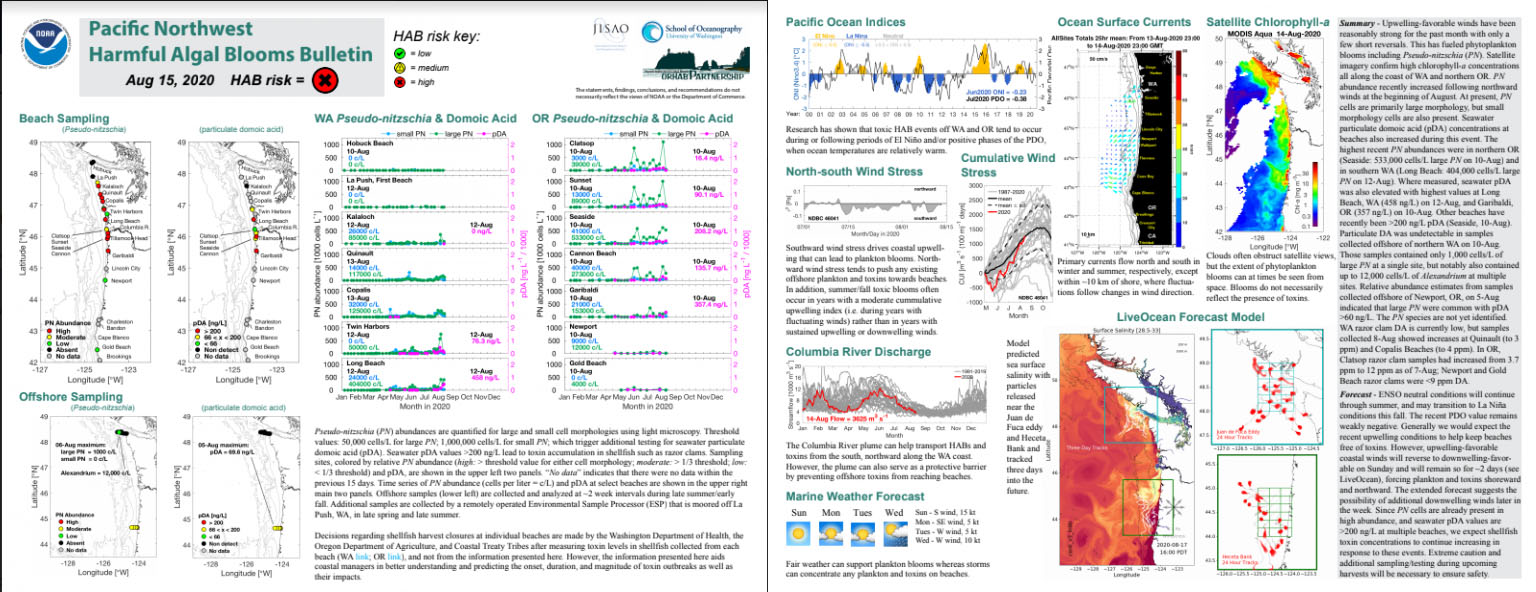We will estimate the economic benefits of the Pacific Northwest Harmful Algal Bloom Bulletin, using a methodology that quantifies the value of information.
Why We Care
The razor clam and Dungeness crab fisheries along the Washington and Oregon coasts have been adversely impacted by marine algae that produce the toxin domoic acid. Since the first detection of domoic acid above its 20 ppm regulatory limit three decades ago, resource managers at the Washington and Oregon Departments of Fish and Wildlife have modified management of the states’ largest recreational bivalve shellfish fishery, razor clams.
The Pacific Northwest (PNW) Harmful Algal Bloom (HAB) Bulletin is a forecasting tool that provides information to managers in both states to facilitate their decisions to open and close shellfisheries, including implementing delayed openings, selective harvests at “safe” beaches, and increasing harvest limits. The HAB Bulletin is being transitioned from a research to an operational product. Once operational, the most current PNW HAB Bulletin will be distributed to managers and other partners on the NANOOS website. This product was originally developed through a partnership among NOAA Northwest Fisheries Science Center, the University of Washington, and the Centers for Disease Control and has since been funded by the NCCOS MERHAB Program. The Bulletin has already helped protect the health of tens of thousands of harvesters and consumers in the region. In Washington, the Bulletin helps managers decide when and where to open the fishery. In Oregon, where only limited tissue toxin data is available, the Bulletin allows managers to systematically prioritize additional sample collections ahead of potential area closures.
In Washington, this fishery can have as many as 400,000 participants during a nine-month series of short-term, monthly harvest “openers.” The fishery is a major source of tourist-related income to small communities along the Washington coast, generating as much as $40 million during October to May, a time when visitation to these communities would otherwise be quite low. The openers are short term to allow state fishery and human health managers sufficient time to ensure that razor clams are free from toxins.
In Oregon, more than 90 percent of the razor clam harvest occurs primarily along 18 miles of its northern coast. Although much smaller in scale than Washington’s recreational fishery, Oregon’s commercial and recreational fisheries contribute as much as $12 million per year in revenues to its coastal communities. In Oregon, the season lasts from October until the middle of July, unless domoic acid levels mandate a closure.
The coastal commercial Dungeness crab fishery is the largest commercial fishery in Washington and Oregon, and it is a major employer in their coastal communities. This fishery has also been closed for extended periods when domoic acid has exceeded regulatory safe levels. To ensure public safety and protect the fishery, the Bulletin provides guidance to managers about when and where Dungeness crabs should be sampled. Although costs for maintaining the Bulletin and some of its associated data streams have been estimated, quantitative estimates of the net economic benefits of the Bulletin have never been conducted. It is critical to assess the net economic benefits of the Bulletin so that policymakers, funding agencies, other stakeholders, and the public can be assured of its value in decision making.

What We Are Doing
The project team will estimate the economic benefits of the PNW HAB Bulletin, using a methodology that quantifies the value of information. Here, the value of information is defined as the difference with and without a HAB forecast, as manifested in the Bulletin, in the economic consequences of implementing a management action. It is expected that publication of the Bulletin would lead to better-informed management actions, which in turn would advance public health goals and improve economic conditions in coastal communities. Researchers hypothesize that the forecasting program would lead to net economic benefits, and seek to estimate the scale of net benefits to provide support for public investment decisions about implementing the program.
Estimating the value of HAB forecasting in the proposed Pacific Northwest case study will involve four steps:
-
-
- Measuring the economic impacts (e.g., harvest losses) of HAB events in the absence of prediction. This step involves an economic impact analysis of the status quo.
- Characterizing the prediction itself. This project will focus on the situation in which the goal of HAB prediction is to predict the occurrence or non-occurrence of a large-scale event within a season. The value of HAB prediction depends on the accuracy or skill of the prediction. This project will assess the value for a range of potential skill levels.
- Examining how decisions would be made in light of a HAB prediction. This step involves identifying a range of potential responses by public and private decision-makers and evaluating their economic consequences.
- Developing an overall measure of prediction value using the model described above.
-
Dr. Di Jin of Woods Hole Oceanographic Institution leads this project. Co-investigators are Dr. Porter Hoagland (Woods Hole Oceanographic Institution), Dr. Ryan McCabe (University of Washington), Dr. Jan Newton (University of Washington), Mr. Dan Ayres (Washington State Department of Fish and Wildlife), and Mr. Matthew Hunter (Oregon Department of Fish and Wildlife). The project is funded through the NCCOS Prevention, Control, and Mitigation of Harmful Algal Blooms Program.
